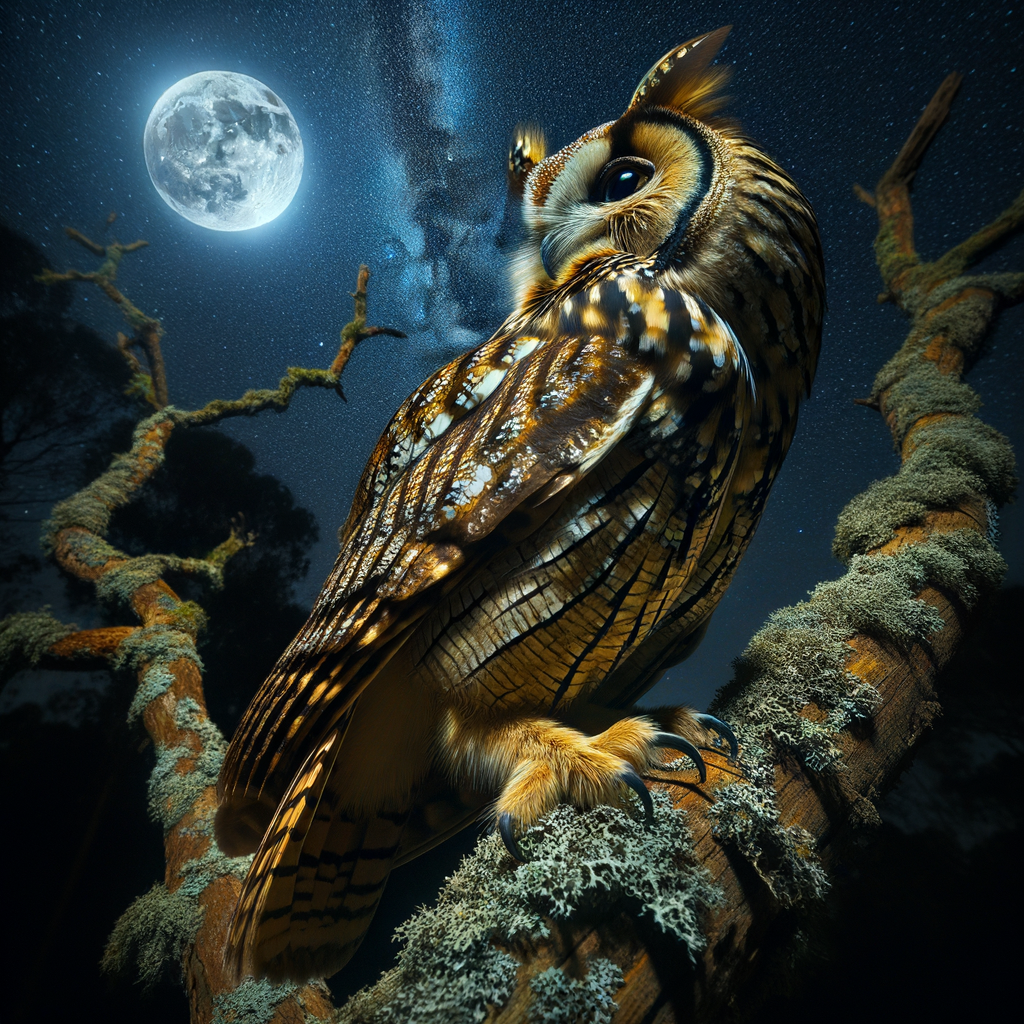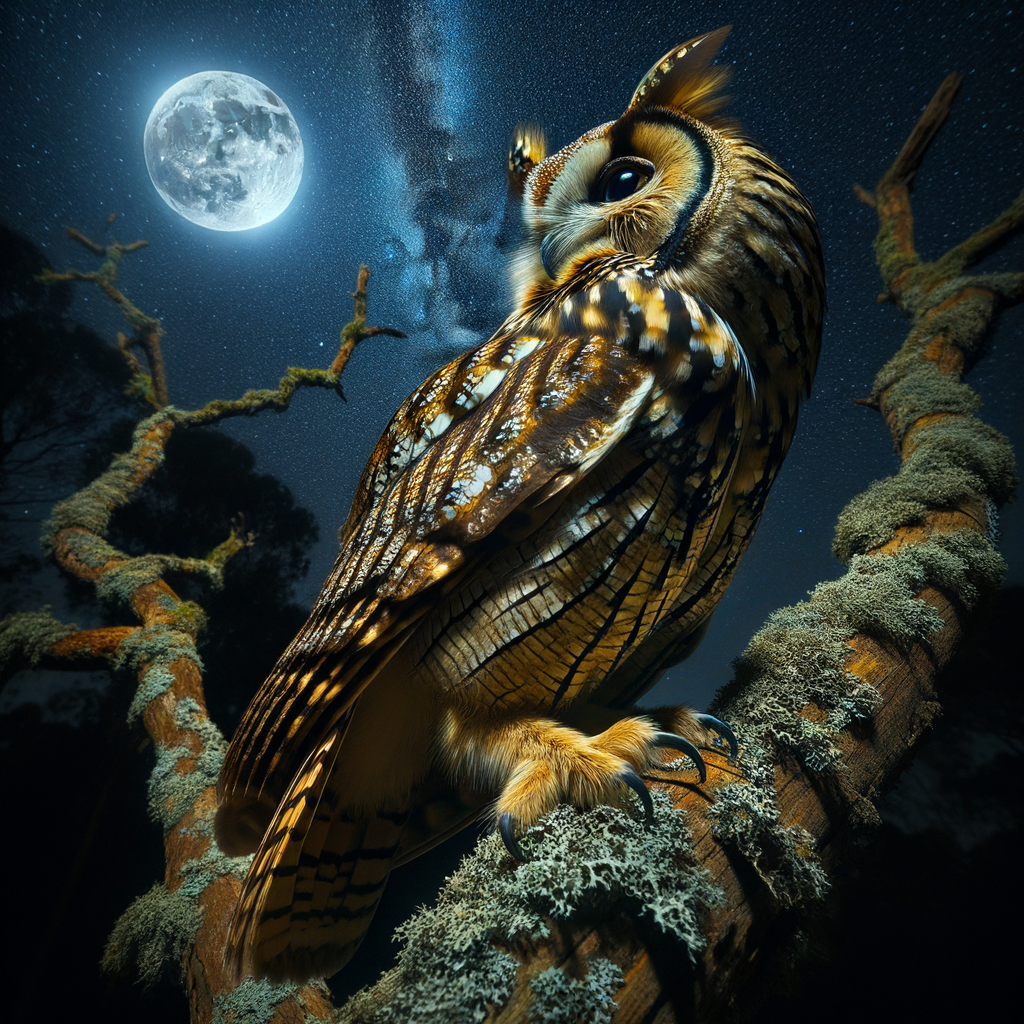
Introduction to Nocturnal Owl Habits
- Overview of nocturnal bird behavior: Nocturnal birds are those that are active during the night. These birds have special adaptations that help them thrive in the dark. They have excellent night vision, heightened hearing, and silent flight. These traits help them hunt and navigate in the dark.
- Specific characteristics of nocturnal owls: Nocturnal owls have unique features that set them apart from other birds. Their large eyes help them see in low light. They also have a special feather structure that allows for silent flight. This makes it easier for them to sneak up on their prey. Additionally, their heads can rotate up to 270 degrees, giving them a wide field of vision.
Understanding Owl Night Activities
Owl Hunting Techniques
- Prey Detection and CaptureOwls have amazing skills to find and catch their prey. They use their sharp vision and excellent hearing. Owls can see well in the dark. Their eyes are big and help them see even in low light. They also have special feathers that make their flight silent. This helps them sneak up on their prey without being heard.
For example, the Barn Owl can hear the tiny sounds made by mice and other small animals. It can even hear these sounds from far away. Once an owl spots its prey, it swoops down quickly and grabs it with its strong talons.
- Unique Hunting Strategies of Different Owl SpeciesDifferent owl species have different ways of hunting. Each type of owl has its own special skills and techniques. Here are a few examples:
- Snowy Owl: This owl lives in cold places like the Arctic. It hunts during the day and night. They sits and waits for its prey to come close. Then, it pounces with great speed.
- Great Horned Owl: This owl is very strong and can hunt larger animals. It can catch rabbits, skunks, and even other birds. The Great Horned Owl uses its powerful talons to grab and hold onto its prey.
- Burrowing Owl: This owl lives in burrows in the ground. It hunts insects, small mammals, and even reptiles. The Burrowing Owl often hunts by running on the ground rather than flying.
Each owl species has adapted to its environment, making them excellent hunters in their own unique ways.
Owl Communication at Night
-
Owl Calls and Signals
These calls can be hoots, screeches, or whistles. Each type of call has a different meaning. For example, a hoot might signal that an owl is claiming its territory, while a screech could be a warning to other owls.
Some owls, like the Barn Owl, have unique calls that can be heard from far away. This helps them stay in touch with their mates or young ones even in the dark.
Owl Species Type of Call Purpose Barn Owl Screech Warning Great Horned Owl Hoot Territory Claim Eastern Screech Owl Whistle Mate Communication -
Role of Communication in Owl Social Structures
Owls are usually solitary birds, but they do come together during mating season. During this time, calls help them find and attract mates.
Once they form a pair, owls use calls to coordinate activities like hunting and caring for their young. For example, the male might call to let the female know he has found food. This teamwork ensures the survival of their chicks.
According to a study by the Cornell Lab of Ornithology, owls also use body language, like fluffing their feathers or bobbing their heads, to communicate non-verbally.
Exploring Owl Behavior Patterns
Owl Night Vision
-
Adaptations for night vision in owls:
Their eyes are very large and have more rods than cones. Rods are cells in the eyes that help with seeing in low light. This makes their night vision much better than ours. Owls also have a special layer in their eyes called the tapetum lucidum. This layer reflects light, making it easier for them to see in the dark.
-
Comparison of owl night vision with other nocturnal birds:
While many nocturnal birds have good night vision, owls are among the best. For example, nightjars and nighthawks also have good night vision, but they do not have the same level of adaptation as owls. Owls’ large eyes and the tapetum lucidum give them an edge. This allows them to hunt more effectively at night compared to other nocturnal birds.
Nocturnal Owl Adaptations
- Physical adaptations for nocturnal life: Owls have special features that help them see and hunt at night. Their large eyes can gather more light, making it easier to see in the dark. Owls also have excellent hearing. Their ears are placed at different heights on their heads, allowing them to pinpoint the exact location of sounds. This helps them catch prey even in complete darkness.
- Behavioral adaptations for hunting and survival: Owls are silent hunters. Their feathers are designed to muffle the sound of their flight. This means they can swoop down on prey without being heard. Owls also have a unique way of hunting. They often sit quietly on a perch and wait for the right moment to strike. This patience and stealth make them effective nocturnal predators.
| Adaptation | Description |
|---|---|
| Large Eyes | Gather more light for better night vision. |
| Asymmetrical Ears | Help pinpoint the location of sounds. |
| Silent Flight | Feathers muffle sound to avoid detection. |
| Perching and Waiting | Allows for stealthy and patient hunting. |
Delving into Owl Species Nocturnal
Case Study: The Barn Owl
-
Overview of the Barn Owl’s Nocturnal Habits
Barn Owls are known for their night-time activities. They hunt mainly at night, using their excellent hearing to locate prey. These owls are very quiet fliers, which helps them sneak up on small animals like mice and voles.
During the day, Barn Owls rest in quiet, hidden places like barns, tree hollows, or old buildings. They are rarely seen during daylight hours.
-
Features and Adaptations of the Barn Owl
Barn Owls have several special features that help them thrive at night:
- Heart-shaped face: This helps funnel sound to their ears, making their hearing very sharp.
- Silent flight: Their feathers are designed to muffle sound, allowing them to fly quietly.
- Excellent night vision: Their large eyes help them see well in low light.
These adaptations make the Barn Owl a skilled nocturnal hunter.
| Feature | Benefit |
|---|---|
| Heart-shaped face | Improves hearing |
| Silent flight | Allows stealthy hunting |
| Excellent night vision | Better sight in the dark |
Case Study: The Snowy Owl
-
The Snowy Owl’s Night Activities
The Snowy Owl is a fascinating bird, especially known for its activities during the night. Unlike many other owls, the Snowy Owl is often active during the day as well. However, during the long Arctic nights, it adapts to hunting in the dark.
Snowy Owls primarily hunt small mammals like lemmings. They use their excellent hearing and vision to locate prey even in low light conditions. According to Wikipedia, a single Snowy Owl can catch up to 1,600 lemmings in a year!
-
Adaptations of the Snowy Owl for Arctic Life
The Snowy Owl has several adaptations that help it survive in the harsh Arctic environment. One key adaptation is its thick plumage, which provides insulation against the cold. The feathers cover even its legs and toes, keeping it warm.Another adaptation is its white coloration, which helps it blend into the snowy surroundings. This camouflage is crucial for both hunting and avoiding predators.
Additionally, the Snowy Owl has a unique ability to store fat. This allows it to survive periods when food is scarce. It can also travel long distances in search of food, sometimes migrating to more temperate regions during the winter.
| Adaptation | Benefit |
|---|---|
| Thick Plumage | Insulation against cold |
| White Coloration | Camouflage in snow |
| Fat Storage | Survival during food scarcity |
Conclusion: The Fascinating World of Nocturnal Owls
-
Key takeaways about nocturnal owl habits and behavior:
- Owls are most active at night, using their excellent night vision and hearing to hunt.
- They have special feathers that allow them to fly silently, making them effective predators.
- Different owl species have unique behaviors and habitats, but all share the trait of being nocturnal.
-
Final thoughts on the importance of understanding owl night activities:
- Learning about owls helps us protect them and their habitats.
- Owls play a crucial role in controlling rodent populations, which benefits the ecosystem.
- By studying owls, we can gain insights into the health of our environment.
In summary, nocturnal owls are fascinating and important creatures. By understanding their habits and behaviors, we can better appreciate their role in nature and work to protect them.
| Aspect | Details |
|---|---|
| Activity | Most active at night |
| Hunting | Uses night vision and hearing |
| Flight | Silent due to special feathers |
| Role | Controls rodent populations |
For more information about owls, you can visit Wikipedia’s page on owls.






